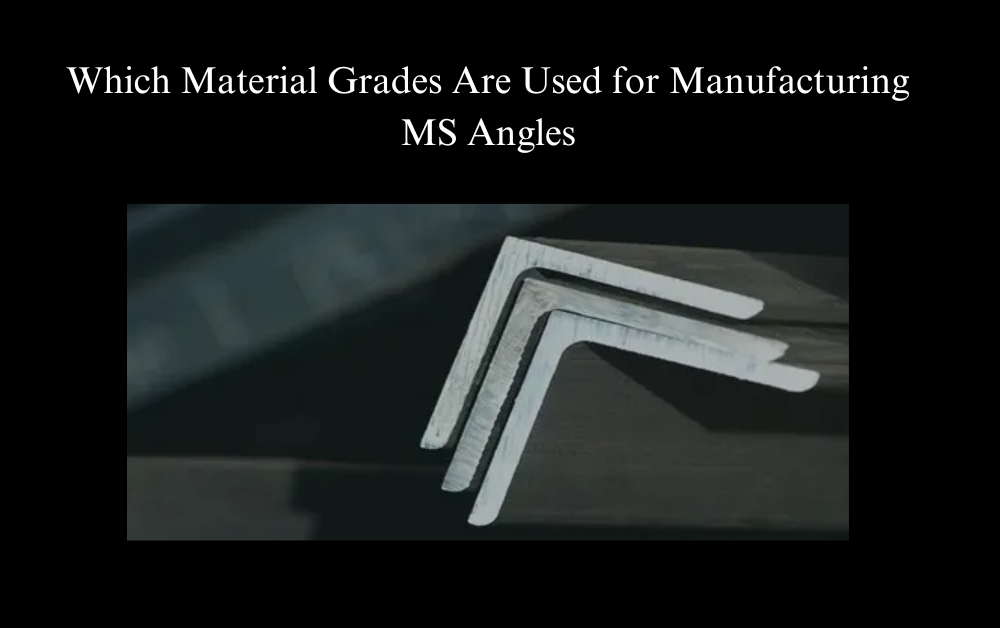MS (Mild Steel) angles are an essential part of many construction and industrial projects. They are commonly used in structures, frames, and supports due to their strength, durability, and cost-effectiveness. However, not all MS angles are the same. Different material grades are used to manufacture MS angles, each offering specific properties suited for various applications.
In this blog, we will discuss the various material grades used for manufacturing MS angles, their characteristics, and how to choose the right one for your project.
What Are MS Angles?

What Are MS Angles and Why Are They Important?
MS angles are structural steel components that are shaped in an “L” form, making them ideal for a variety of applications. These angles are used in building frames, support beams, machinery, and even in the automotive industry. MS angles offer a combination of strength and flexibility, making them a popular choice for construction and fabrication.
Where Are MS Angles Commonly Used?
MS angles are widely used in industries like construction, engineering, and manufacturing. Their versatility allows them to be used in building structures, creating frames for machinery, and even reinforcing large machines. Whether it’s a small project or a massive construction, MS angles play a crucial role in ensuring strength and support.
Understanding Material Grades for MS Angles
What Is a Material Grade?
Material grades refer to the classification of materials based on their chemical composition and mechanical properties. These grades are important because they help determine the material’s strength, durability, and how well it can be used in different applications.
For MS angles, the material grade influences how strong the angle is, how well it handles stress, and how long it will last in various conditions. Choosing the right material grade is crucial to the success of your project.
Why Are Material Grades Important for MS Angles?
Choosing the right material grade for your MS angles is essential to ensure that the angle performs well in your specific application. Different grades have varying levels of strength, corrosion resistance, and flexibility. By selecting the proper grade, you can make sure that your MS angle is suitable for the project’s demands and environmental conditions.
Common Material Grades Used in MS Angles
Grade IS 2062: A Popular Choice for MS Angles
What Is IS 2062?
IS 2062 is one of the most common material grades used in MS angles. It refers to a specification developed by the Bureau of Indian Standards (BIS) for hot-rolled mild steel used in structural applications. This grade is widely used in construction and fabrication due to its excellent mechanical properties and affordability.
Why Is IS 2062 Popular?
IS 2062 is preferred for its combination of good strength and cost-effectiveness. It offers a balance between strength and flexibility, making it suitable for a wide range of uses in construction and industrial settings. It is especially popular in the Indian market, where it is used in bridges, buildings, and other structural components.
Applications of IS 2062 MS Angles
- Construction frames and supports
- Building bridges
- Machinery frames
- Fabrication of heavy equipment
Grade ASTM A36: A Versatile Material for MS Angles
What Is ASTM A36?
ASTM A36 is an American standard for mild steel used in structural shapes like angles, beams, and plates. It is known for its good weldability, machinability, and strength, making it a versatile option for different types of projects.
Why Is ASTM A36 a Good Choice?
ASTM A36 is widely used due to its high level of toughness and its ability to be used in various applications. It is especially useful in environments where welding is required, as this grade of steel welds easily and maintains its strength after being welded.
Applications of ASTM A36 MS Angles
- Construction of bridges and buildings
- Manufacturing of machinery and equipment
- Support structures in industrial settings
- General fabrication work
Grade EN 10025: A Strong and Durable Option
What Is EN 10025?
EN 10025 is a European standard for structural steel that offers high strength and durability. It is commonly used in heavy-duty structures that require strong, reliable materials. This material grade is available in several variations, including S275 and S355, with each variation offering different levels of strength.
Why Is EN 10025 a Preferred Choice for Heavy Structures?
EN 10025 is favored for its high strength and load-bearing capabilities. It can handle more stress and pressure compared to other material grades, making it ideal for large-scale projects like bridges, towers, and industrial buildings.
Applications of EN 10025 MS Angles
- Heavy structural components
- Industrial machinery support
- Bridges and towers
- Construction of large buildings
Grade S235JR: A Standard for Structural Applications
What Is S235JR?
S235JR is a non-alloy structural steel grade used in MS angles for various general-purpose structural applications. It offers a good balance of strength and flexibility and is commonly used in everyday construction projects.
Why Is S235JR a Reliable Option?
S235JR is a cost-effective option for general-purpose construction needs. It provides enough strength for most applications while being flexible enough to handle stress without breaking or cracking. It is easy to work with, making it a popular choice for basic structural work.
Applications of S235JR MS Angles
- General construction and framing
- Machinery and equipment support
- Residential and commercial building structures
Grade S355: A High-Strength Option for Demanding Projects
What Is S355?
S355 is a high-strength, non-alloy structural steel grade. It is commonly used for projects that require superior strength and durability, such as bridges, heavy machinery, and industrial buildings. S355 offers greater tensile strength than many other mild steel grades, making it an excellent choice for heavy-duty applications.
Why Is S355 a Top Choice for High-Stress Applications?
S355 is designed to handle high levels of stress, making it ideal for projects where structural integrity is critical. It has excellent load-bearing capabilities and can withstand harsh conditions without losing its strength or flexibility
Applications of S355 MS Angles
- Construction of bridges and industrial buildings
- Reinforcing structures in heavy machinery
- High-stress construction projects
How to Choose the Right Material Grade for MS Angles
Consider the Application
The first thing to consider when choosing a material grade for MS angles is the application. If your project requires high strength and load-bearing capacity, grades like S355 or EN 10025 would be more suitable. For general construction, more common grades like IS 2062 or ASTM A36 may be sufficient
Evaluate Environmental Factors
Consider the environment in which the MS angles will be used. If the structure will be exposed to harsh weather conditions or corrosive environments, it is essential to choose a material grade that offers some level of resistance, such as ASTM A36. Ensure that the material can withstand any temperature, moisture, or chemical exposure it might face
Look at Cost-Effectiveness
Another important factor is cost. While high-strength materials like S355 offer better durability, they may also come at a higher cost. Balancing performance with budget is crucial to making the right decision. If your project does not require extreme strength, opting for a more affordable grade like IS 2062 may save you money without sacrificing quality.
Conclusion
Choosing the right material grade for manufacturing MS angles is essential for ensuring the success and longevity of your project. Each material grade offers specific advantages in terms of strength, flexibility, and durability. Whether you are working on a small construction project or a large-scale industrial application, understanding the differences between material grades can help you make an informed decision.
By considering factors like application, environmental conditions, and budget, you can select the best material grade for your MS angles and ensure that your structure is safe, strong, and long-lasting.
For more insightful articles related to this topic, feel free to visit penwhatmatters.com








